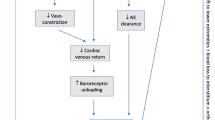Abstract
Centrally and locally mediated sympathetic vasoconstrictor responses in skeletal muscle and subcutaneous tissue were studied in six patients with definite multiple sclerosis and severely affected thermoregulatory sweating. The purpose of the study was to evaluate vasomotor function in patients with pronounced thermoregulatory dysfunction and to differentiate between locally and centrally elicited vasomotor reflexes in two different tissues. The method used, the 133-Xenon washout technique, makes such a distinction possible. In spite of the severe sweating disturbances, we found centrally and locally mediated sympathetic vasomotor reflexes to be preserved in skeletal muscle and subcutaneous tissue. The results support the view that sudomotor and vasomotor functions are independently controlled. Previously described differences in sympathetic vasoconstrictor responses in skeletal muscle and subcutaneous tissue in several other neurological disorders are not present in patients with multiple sclerosis, based on our results.
Similar content being viewed by others
References
Lumsden CE. The neuropathology of multiple sclerosis. In: Vinken PJ, Bruyn DW, eds.Handbook of Clinical Neurology, Vol. IX. Amsterdam: North Holland, 1970; 217–309.
Noronha MJ, Vas CJ, Aziz H. Autonomic dysfunction (sweating responses) in multiple sclerosis.J Neurol Neurosurg Psychiat 1968;31: 19–22.
Vas CJ. Sexual impotence and some autonomic disturbances in men with multiple sclerosis.Acta Neurol Scand 1969;45: 166–182.
Sullivan F, Hutchinson M, Bahandeka S, Moore RE. Chronic hypothermia in multiple sclerosis.J Neurol Neurosurg Psychiat 1987;50: 813–835.
Neubauer B, Gundersen HJG. Analysis of heart rate variations in patients with multiple sclerosis.J Neurol Neurosurg Psychiat 1978;41: 417–419.
Mutani R, Clemente S, Lamberti A, Monaco F. Asssessment of autonomic disturbances in multiple sclerosis by measurement of heart rate responses to deep breathing and to standing.Ital J Neurol Sci 1982;2: 111–114.
Senaratne MPJ, Carroll D, Warren KG, Kappagoda T. Evidence for cardiovascular autonomic nerve dysfunction in multiple sclerosis.J Neurol Neurosurg Psychiat 1984;47: 947–952.
Sterman AB, Coyle PK, Panasci DJ, Grimson R. Disseminated abnormalities of cardiovascular autonomic functions in multiple sclerosis.Neurology 1985;35: 1665–1668.
Pentland B, Ewing DJ. Cardiovascular reflexes in multiple sclerosis.Eur Neurol 1987;26: 46–50.
Nordenbo AM, Boesen F, Andersen EB. Cardiovascular autonomic function in multiple sclerosis.J Autonom Nerv Syst 1989;26: 77–84.
Thomaides TN, Zoukos Y, Chaudhuri KR, Mathias CJ. Physiological assessment of aspects of autonomic function in patients with secondary progressive multiple sclerosis.J Neurol 1993240: 139–143.
Gauer OH, Thron HL. Postural changes in the circulation. In:Handbook of Physiology, Circulation, section 2, III Washington DC: American Physiological Society, 1965; 2409–2439.
Skagen K. Sympathetic reflex control of blood flow in human subcutaneous tissue during orthostatic manoeuvres. Copenhagen: Laegeforeningens Forlag, 1983; 7–43.
Andersen EB, Boesen F, Henriksen O. Local and central sympathetic reflex control of blood flow in skeletal muscle and subcutaneous tissue in normal man.Clin Physiol 1991;11: 451–458.
Poser CM, Pathy DW, Scheinberg L et al. New diagnostic criteria for multiple sclerosis. Guidelines for research protocols.Ann Neurol 1983;13: 227–231.
Kurtzke J. Rating neurological impairment in multiple sclerosis: an expanded disability status scale (EDSS).Neurology 1983;33: 1444–1452.
Guttmann L. The management of Quinizarin sweat test.Postgrad Med J 1947;23: 353–366.
Johnson RH, Spalding JMK.Disorders of the Autonomic Nervous System. Oxford: Blackwell, 1974.
Henriksen O, Sejrsen P. Local reflex in microcirculation in human cutaneous tissue.Acta Physiol Scand 1976;98: 227–231.
Henriksen O, Sejrsen P. Local reflex in microcirculation in human skeletal muscle.Acta Physiol Scand 1977;99: 19–26.
Nielsen SL. Adipose tissue blood flow determined by the washout of locally injected133Xenon.Scand J Clin Lab Invest 1972;29: 31–36.
Henriksen O. Local sympathetic reflex mechanism in regulation of blood flow in human subcutaneous adipose tissue.Acta Physiol Scand 1977; suppl. 450: 7–48.
Karaszewski JW, Reder AT, Maselli R, Brown M, Arnason BGW. Sympathetic skin responses are decreased and lymphocyte beta-adrenergic receptors are increased in progressive multiple sclerosis.Ann Neurol 1990:27: 366–372.
Johnson DA, Roth GM, Craig W McK. Autonomic pathways in the spinal cord.J Neurosurg 1952;9: 599–605.
Prout BJ, Coote JH, Downman CBB. Independence of central controls of vascular and sweat gland responses in the paw of the cat.J Neurol Neurosurg Psychiat 1965;28: 223–227.
Jänig W, Kümmel H, Functional discrimination of postganglionic neurones to the cat's hindpaw with respect to the skin potentials recorded from the hairless skin.Pflügers Arch 1977;371: 217–225.
Bini G, Hagbarth K-E, Hynninen P, Wallin BG. Thermoregulatory and rhythm-generating mechanisms governing the sudomotor and vasoconstrictor outflow in human cutaneous nerves.J Physiol 1980;306: 537–552.
Bini G, Hagbarth K-E, Hynninen P, Wallin BG. Regional similarities and differences in thermoregulatory vaso- and sudomotor tone.J Physiol 1980;306: 553–565.
Fagius J, Wallin BG. Sympathetic reflex latencies and conduction velocities in normal man.J Neurol Sci 1990;47: 433–448.
Cartlidge NEF. Autonomic function in multiple sclerosis.Brain 1972;95: 661–664.
Hilsted J, Madsbad S, Sestoft L. Subcutaneous blood flow during insulin-induced hypoglycaemia: studies in juvenile diabetics with and without autonomic neuropathy and in normal subjects.Clin Physiol 1982;2: 323–332.
Andersen EB, Boesen F, Henriksen O, Sonne M. Blood flow in skeletal muscle of tetraplegic man during postural changes.Clin Sci 1986;70: 321–325.
Andersen EB, Boesen F. Sympathetic vasoconstrictor reflexes in Parkinson's disease with autonomic dysfunction.Clin Aut Res 1977;7: 5–11.
Author information
Authors and Affiliations
Rights and permissions
About this article
Cite this article
Andersen, E.B., Nordenbo, A.M. Sympathetic vasoconstrictor responses in multiple sclerosis with thermoregulatory dysfunction. Clinical Autonomic Research 7, 13–16 (1997). https://doi.org/10.1007/BF02267621
Received:
Accepted:
Issue Date:
DOI: https://doi.org/10.1007/BF02267621




